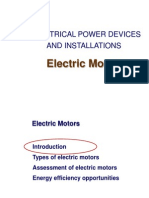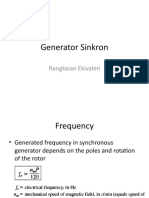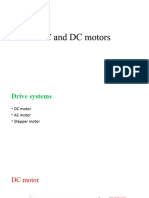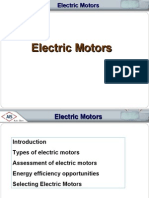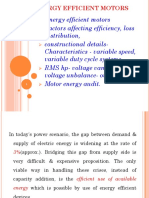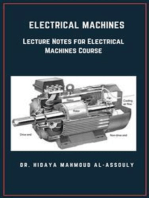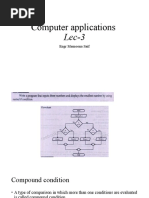0 ratings0% found this document useful (0 votes)
14 viewsLecture 3
Lecture 3
Uploaded by
Shaheryar MansoorSynchronous machines are electric motors or generators where the rotation of the shaft is synchronized with the frequency of the supply current. They have a field winding supplied by an external DC source to create a fixed number of pole pairs. This induces an electromotive force proportional to the relative motion between the magnetic field and armature winding. Synchronous generators produce electricity at a frequency synchronized to the mechanical rotational speed, and their performance can be described using parameters determined from open and short circuit tests.
Copyright:
© All Rights Reserved
Available Formats
Download as PDF, TXT or read online from Scribd
Lecture 3
Lecture 3
Uploaded by
Shaheryar Mansoor0 ratings0% found this document useful (0 votes)
14 views6 pagesSynchronous machines are electric motors or generators where the rotation of the shaft is synchronized with the frequency of the supply current. They have a field winding supplied by an external DC source to create a fixed number of pole pairs. This induces an electromotive force proportional to the relative motion between the magnetic field and armature winding. Synchronous generators produce electricity at a frequency synchronized to the mechanical rotational speed, and their performance can be described using parameters determined from open and short circuit tests.
Copyright
© © All Rights Reserved
Available Formats
PDF, TXT or read online from Scribd
Share this document
Did you find this document useful?
Is this content inappropriate?
Synchronous machines are electric motors or generators where the rotation of the shaft is synchronized with the frequency of the supply current. They have a field winding supplied by an external DC source to create a fixed number of pole pairs. This induces an electromotive force proportional to the relative motion between the magnetic field and armature winding. Synchronous generators produce electricity at a frequency synchronized to the mechanical rotational speed, and their performance can be described using parameters determined from open and short circuit tests.
Copyright:
© All Rights Reserved
Available Formats
Download as PDF, TXT or read online from Scribd
Download as pdf or txt
0 ratings0% found this document useful (0 votes)
14 views6 pagesLecture 3
Lecture 3
Uploaded by
Shaheryar MansoorSynchronous machines are electric motors or generators where the rotation of the shaft is synchronized with the frequency of the supply current. They have a field winding supplied by an external DC source to create a fixed number of pole pairs. This induces an electromotive force proportional to the relative motion between the magnetic field and armature winding. Synchronous generators produce electricity at a frequency synchronized to the mechanical rotational speed, and their performance can be described using parameters determined from open and short circuit tests.
Copyright:
© All Rights Reserved
Available Formats
Download as PDF, TXT or read online from Scribd
Download as pdf or txt
You are on page 1of 6
Synchronous Machine
Prepared By: Engr. Osama Majeed Butt
Synchronous Machine
• Electric Motor in which, at steady state, the rotation of the shaft is
synchronized with frequency of supply current
• The speed of the synchronous motor is determined by the number of
magnetic poles and the line frequency
• Types:
Synchronous Generator
Synchronous Motor
Electrical Mechanical
Energy Machine Energy
Prepared By: Engr. Osama Majeed Butt
Construction of synchronous machines
• AC machines that have a field circuit supplied by an external DC
source
Prepared By: Engr. Osama Majeed Butt
Winding of Synchronous Machine
• Armature Winding
• Deliver of Consume AC Power
• Field Winding
• Supplied by DC supply to create fix number of pole pair
• Induce emf/voltage is directly proportional to relative motion
Prepared By: Engr. Osama Majeed Butt
Synchronous Generator
• Synchronous generators produce electricity whose frequency is
synchronized with the mechanical rotational speed
• Equivalent circuit describe by using
• Relation between field current and flux
• Synchronous reactance
• Armature resistance
• Use open-circuit test & short-circuit test to determine these
parameters
Prepared By: Engr. Osama Majeed Butt
Prepared By: Engr. Osama Majeed Butt
You might also like
- Lecture 5Document13 pagesLecture 5Muhammad Umar MunirNo ratings yet
- AC Machine Lecture No6Document43 pagesAC Machine Lecture No6Mohammed Dyhia AliNo ratings yet
- Unit 4 DC MachinesDocument13 pagesUnit 4 DC Machineskumarwaris123No ratings yet
- EM CH-4-5-6 Ac MachinesDocument80 pagesEM CH-4-5-6 Ac Machinesmuhammad.anas2007No ratings yet
- Introduction To Synchronous Generators: By: Aamir MehmoodDocument16 pagesIntroduction To Synchronous Generators: By: Aamir MehmoodMOHSIN_IIUINo ratings yet
- Chapter 5 - AC Electrical MachinesDocument31 pagesChapter 5 - AC Electrical MachinesIqhfan HarisNo ratings yet
- Lecture 7 - Synchronous Generators PDFDocument38 pagesLecture 7 - Synchronous Generators PDFMd Rodi BidinNo ratings yet
- Synchronous Machines MaterialDocument10 pagesSynchronous Machines MaterialWitchayut SudthanyaratNo ratings yet
- AC Power Generation and Voltage RegulationDocument48 pagesAC Power Generation and Voltage Regulationdepths311No ratings yet
- Chapter 5ADocument20 pagesChapter 5ASloom NusiratNo ratings yet
- C5 SyncMachineDocument25 pagesC5 SyncMachineBassemGhorabNo ratings yet
- Motors EditedDocument24 pagesMotors Editedpaules30No ratings yet
- MachineDocument16 pagesMachineRahulNo ratings yet
- Lecture 8 DC Machines IIDocument15 pagesLecture 8 DC Machines IIMohamed HosamNo ratings yet
- Synchronous MachineDocument34 pagesSynchronous Machinefakeacc04aNo ratings yet
- Electrical Motors EPDI2013Document51 pagesElectrical Motors EPDI2013neocentricgenius100% (1)
- 5 Generator SinkronDocument36 pages5 Generator SinkronAchmad YukrisnaNo ratings yet
- AC and DC MotorsDocument24 pagesAC and DC MotorssungadomsNo ratings yet
- National Institute of Technology, Hamirpur: DC MachinesDocument14 pagesNational Institute of Technology, Hamirpur: DC MachinesAbhinav PaliwalNo ratings yet
- Electrical MotorsDocument170 pagesElectrical MotorsgayathrikanduriNo ratings yet
- AC Synchronous Motors: EE 3283 Electrical MachinesDocument29 pagesAC Synchronous Motors: EE 3283 Electrical MachinesJunaid KhanNo ratings yet
- Electrical MachinesDocument45 pagesElectrical Machinesaravme9No ratings yet
- Working Principle of DC Motor & Back EMFDocument13 pagesWorking Principle of DC Motor & Back EMFsatyammishra1907No ratings yet
- مقدمة في الالات الكهربيةDocument25 pagesمقدمة في الالات الكهربيةMahmoud Adel100% (1)
- 노트 03Document20 pages노트 03emmanuelmuksinNo ratings yet
- Electrical MotorsDocument53 pagesElectrical MotorsMahesh100% (10)
- EE360 - Synchronous MachinesDocument85 pagesEE360 - Synchronous MachinesAliAl-jaziri100% (1)
- IG: Induction Machines Run at Beyond Synchronous Speed With Appropriate Excitation in PlaceDocument17 pagesIG: Induction Machines Run at Beyond Synchronous Speed With Appropriate Excitation in PlaceprakashNo ratings yet
- DC MotorDocument28 pagesDC MotorSanchit rajNo ratings yet
- ECAM Unit-III Energy Efficient MotorsDocument59 pagesECAM Unit-III Energy Efficient MotorsRama raoNo ratings yet
- "Synchronous Generators": AV-222 Electromechanical SystemsDocument10 pages"Synchronous Generators": AV-222 Electromechanical SystemsSyed HaiderNo ratings yet
- Chapter 5CDocument18 pagesChapter 5CSloom NusiratNo ratings yet
- AllDocument72 pagesAllfischerdavid1357No ratings yet
- BEE - MachinesDocument15 pagesBEE - Machineswaheedarbab9302No ratings yet
- Electric Drives-L2-DC Motor DrivesDocument20 pagesElectric Drives-L2-DC Motor DrivesHarshal KanumuriNo ratings yet
- AC Motor Single PhaseDocument14 pagesAC Motor Single PhaseMohamed HAMDYNo ratings yet
- "Induced Torque In: AV-222 Electromechanical SystemsDocument8 pages"Induced Torque In: AV-222 Electromechanical SystemsSyed HaiderNo ratings yet
- AC Generator: Group 3 - CE-2109Document47 pagesAC Generator: Group 3 - CE-2109Krizelle ManaloNo ratings yet
- AC Machines - 2024 - New - UpdatedDocument51 pagesAC Machines - 2024 - New - UpdatedrwpsoyofblhowrjtxqNo ratings yet
- EE 7 DC Machines Lecture SlidesDocument80 pagesEE 7 DC Machines Lecture SlidesYestin LusterioNo ratings yet
- Chapter4 Synchronous MachinesDocument34 pagesChapter4 Synchronous Machinessatyakar_vvk100% (3)
- DC Motor: Dheeban S S Assistant Professor Department of EEE AAA College of Engineering and Technology SivakasiDocument60 pagesDC Motor: Dheeban S S Assistant Professor Department of EEE AAA College of Engineering and Technology Sivakasimaheswari MNo ratings yet
- AGK - Electrics 15 DC Generation 30 S7Document31 pagesAGK - Electrics 15 DC Generation 30 S7Cemalettin öztoprakNo ratings yet
- AC Generators: Prepared By: M.J. ShornaDocument6 pagesAC Generators: Prepared By: M.J. ShornaRehnuma NoorNo ratings yet
- Lab 3b PPT - Series MotorDocument23 pagesLab 3b PPT - Series MotorLiaqat AliNo ratings yet
- Electrical Motors: ECE131 Basic Electrical & Electronics EnggDocument58 pagesElectrical Motors: ECE131 Basic Electrical & Electronics EnggVinamra MittalNo ratings yet
- AC GeneratorDocument16 pagesAC Generatorrekhachauhan0406No ratings yet
- BLDC MotorsDocument37 pagesBLDC MotorsCursed to DefyNo ratings yet
- Chapter 3Document24 pagesChapter 3onrsvs34No ratings yet
- Synchronous Motors: (LEC.#4) (Electrical Machines-Ii) Subject Teacher: Engr. Ali AbbasDocument24 pagesSynchronous Motors: (LEC.#4) (Electrical Machines-Ii) Subject Teacher: Engr. Ali AbbasMalika RaniNo ratings yet
- Lecture#5Document35 pagesLecture#520pwmct0739No ratings yet
- Lecture Seven - Electrical MotorsDocument91 pagesLecture Seven - Electrical Motorsnickokinyunyu11No ratings yet
- Electrical Machines: Lecture Notes for Electrical Machines CourseFrom EverandElectrical Machines: Lecture Notes for Electrical Machines CourseNo ratings yet
- Boat Maintenance Companions: Electrics & Diesel Companions at SeaFrom EverandBoat Maintenance Companions: Electrics & Diesel Companions at SeaNo ratings yet
- Some Power Electronics Case Studies Using Matlab Simpowersystem BlocksetFrom EverandSome Power Electronics Case Studies Using Matlab Simpowersystem BlocksetNo ratings yet
- Simulation of Some Power Electronics Case Studies in Matlab Simpowersystem BlocksetFrom EverandSimulation of Some Power Electronics Case Studies in Matlab Simpowersystem BlocksetNo ratings yet
- Simulation of Some Power Electronics Case Studies in Matlab Simpowersystem BlocksetFrom EverandSimulation of Some Power Electronics Case Studies in Matlab Simpowersystem BlocksetNo ratings yet
- Small Dynamos and How to Make Them - Practical Instruction on Building a Variety of Machines Including Electric MotorsFrom EverandSmall Dynamos and How to Make Them - Practical Instruction on Building a Variety of Machines Including Electric MotorsNo ratings yet
- Influence of System Parameters Using Fuse Protection of Regenerative DC DrivesFrom EverandInfluence of System Parameters Using Fuse Protection of Regenerative DC DrivesNo ratings yet
- Lecture 9Document8 pagesLecture 9Shaheryar MansoorNo ratings yet
- Lecture 5Document8 pagesLecture 5Shaheryar MansoorNo ratings yet
- Lecture 2Document10 pagesLecture 2Shaheryar MansoorNo ratings yet
- Lecture 1Document14 pagesLecture 1Shaheryar MansoorNo ratings yet
- Lecture 02 Fly AshDocument16 pagesLecture 02 Fly AshShaheryar MansoorNo ratings yet
- Lecture 4Document5 pagesLecture 4Shaheryar MansoorNo ratings yet
- Lab 2Document18 pagesLab 2Shaheryar MansoorNo ratings yet
- Lec 3Document21 pagesLec 3Shaheryar MansoorNo ratings yet
- Title PageDocument3 pagesTitle PageShaheryar MansoorNo ratings yet















